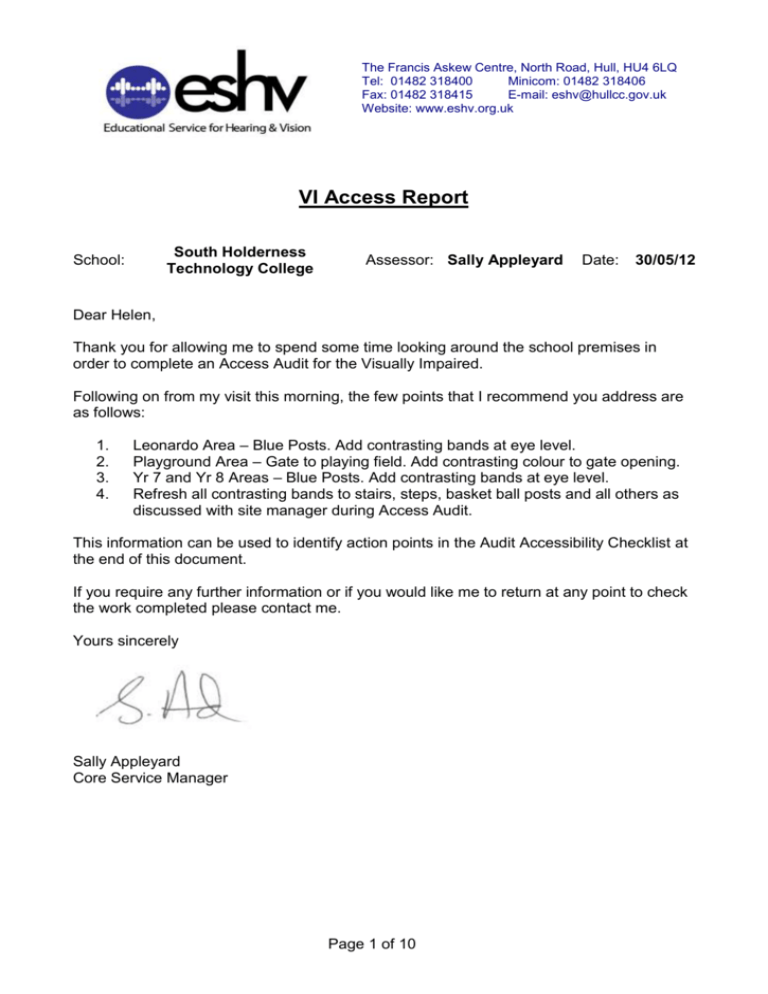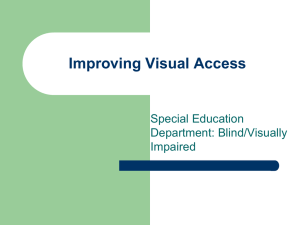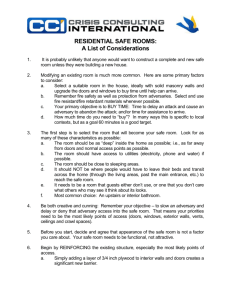Educational Service for Hearing & Vision
advertisement

The Francis Askew Centre, North Road, Hull, HU4 6LQ Tel: 01482 318400 Minicom: 01482 318406 Fax: 01482 318415 E-mail: eshv@hullcc.gov.uk Website: www.eshv.org.uk VI Access Report South Holderness Technology College School: Assessor: Sally Appleyard Date: 30/05/12 Dear Helen, Thank you for allowing me to spend some time looking around the school premises in order to complete an Access Audit for the Visually Impaired. Following on from my visit this morning, the few points that I recommend you address are as follows: 1. 2. 3. 4. Leonardo Area – Blue Posts. Add contrasting bands at eye level. Playground Area – Gate to playing field. Add contrasting colour to gate opening. Yr 7 and Yr 8 Areas – Blue Posts. Add contrasting bands at eye level. Refresh all contrasting bands to stairs, steps, basket ball posts and all others as discussed with site manager during Access Audit. This information can be used to identify action points in the Audit Accessibility Checklist at the end of this document. If you require any further information or if you would like me to return at any point to check the work completed please contact me. Yours sincerely Sally Appleyard Core Service Manager Page 1 of 10 The Francis Askew Centre, North Road, Hull, HU4 6LQ Tel: 01482 318400 Minicom: 01482 318406 Fax: 01482 318415 E-mail: eshv@hullcc.gov.uk Website: www.eshv.org.uk South Holderness Technology College Access Audit for the visually impaired 1. Structural and Systems modifications. 2. Audit of accessibility to school buildings. Page 2 of 10 1. Structural and Systems modifications. for the Visually Impaired Page 3 of 10 Structural and Systems Modifications. Access in respect of Visual Impairment. The following recommendations are offered from the perspective of the Mobility Officer, with responsibility for the safe independence of people with visual impairment. Visual impairment is so complex in its diversity of causes and implications that, in order to simplify the requirements for safe access to buildings it will be advisable to take into account the following two generalisations: Blind Those travellers with profound visual impairment (blind) will, almost invariably, have undergone intensive training in mobility and orientation techniques to address most conventional access situations and contingencies. This might involve the use of a range of mobility aids, including guide dogs. Alternatively, they will be attended by a sighted guide with responsibility for their safety. No amount of visual highlighting will ease their access. Seemingly hazardous features might be regarded as potential points of tactile reference for blind travellers and their removal considered inadvisable. Reduced vision In the main, visual impairment can be measured by degrees of debility and each individual will use vision in his own way. To simplify and generalise this situation, it will be best, when carrying out an access audit, to assume that the worst visual conditions apply to all travellers (sighted and otherwise), within and without the building. There might be a fire in the building, the lights are off, the building is full of smoke and it is dark outside, it will be fair to assume that each evacuee will be equally debilitated in terms of their vision. Indeed, the blind traveller, in this situation, will have superior skills. If the above conditions are assumed when carrying out an access audit, all potentially hazardous situations will become apparent. Areas for particular attention: Approach from outside, Main Entrance The visitor with a visual impairment will probably not drive to the building and will perhaps not necessarily approach the main entrance from the car park. The audit should begin on the outside approach to the building, taking into account the level of visual information which highlights the Main Entrance from, perhaps, the nearest ‘bus stop. Periphery It is important to check the outside pathways, close to the buildings. Check particularly for outward opening windows, at head height and for missing or broken drain covers and similar trip hazards. If an area ‘round the back’ of the building is generally considered ‘out of bounds’, this area should be given particular attention, since it is in just such areas where people with visual impairment might get lost or disorientated. Page 4 of 10 Reception area Ideally, the receptionist(s) might have sufficient training and experience to pre-empt any difficulty encountered by a visually impaired visitor. Training in this area is strongly recommended and can be provided by this Service. It should be visually clear where the reception desk is situated following entrance to the building. It is advisable that the receptionist should have a view of approaching visitors in order to ease access before the point of entry. Flooring It is recommended that flooring, especially close to exits, should not be overly shiny, in order not to give misleading information regarding sources of light. It is generally required that, where a door leads outdoors (to safety), there should be a distinct change of surface, conventionally a mat, as a tactile indicator of this particular point of exit (as distinct from any other door leading into a room etc). Doors Outgoing doors must open outwards, in order to allow ease of mass evacuation. Where doors are fitted with mechanical closers, they must be allowed to close unhindered and wedges must be completely abandoned as they hold doors only partly open, creating extreme hazard in reduced visibility. Viewing panels/windows, within doors must be unobscured by documents, labels, notices etc, since their purpose is to reduce accidental injury. However, doors which are glazed down to ground level, should have the lower half obscured, since this tends to give false information regarding clear access in emergency situations. Doors which open outward into a corridor or passage, against the flow of travellers, should be re-hung to open inward, where practicable. The alternative to this would be a firm policy to keep such doors locked when not in use. This situation commonly arises with cupboard doors, caretaker’s store (hazardous chemicals) and ‘Access Toilets’. Where an outgoing door has an integral step down, within the threshold, this might be considered hazardous. An adjustment might be made to create an extended step or platform to a point beyond the arc of the door. Access (aka ‘Disabled’) Toilets Access toilets create unavoidable hazard for those with reduced vision, as often their doors open outward to allow turning space within, for wheelchairs. The doors need to be free moving and lightweight and consequently do not have mechanical closing devices. Wherever possible, some compromise in favour of visual impairment must be considered. (The obligatory mirror, placed within an access toilet or lift, must allow the exiting occupant in a wheelchair, to view access through the door behind, when reversing.) Page 5 of 10 Steps Remembering that blind people will have a range of skills to negotiate steps, it will nevertheless be advantageous to apply some tactile indicator, particularly at the approach to the descent. This might take the form of a non-slip strip applied close to the top step. The handrail should extend some distance beyond the start and end of a flight of stairs, ideally shaped to correspond with the changes of floor levels. Steps should be highlighted with a suitable non-slip, high contrast paint, ideally bright yellow. This highlighting might take the form of a 10cm strip, applied judiciously to the topmost tread and the bottom riser, at the very least. Alternatively, the highlighting might be applied to each tread, if only at the extreme edges. (Seek advice for more precise detail from this Service.) Experienced blind travellers will tend to maintain a ‘centre line’ route in corridors etc, though they benefit from a ‘stay left’ rule on stairs. Labelling It is important that signage that identifies rooms, toilets, lifts etc should be of optimal visibility. It is recommended that all text should be printed in a sans serif font, bold and in high contrast to the background material, ideally with a matt finish. Labels should be fixed at head height, remembering that visitors might be children, wheelchair users, visually impaired, of short stature or any combination of these. Exit signs (especially’ Fire Exits) Fire Exit signs are commonly placed very high above a door. This is inappropriate for so many reasons, not least of which is the fact that people with visual impairment will be disadvantaged. Perhaps more significantly, in the event of a fire, when the area is filling with smoke from the ceiling downward, these signs quickly become obscured and evacuees will tend not to look upward. Dining Area The Dining or Food Service area might present a number of hazards: Attention might be given to hot, wet and slippery surfaces and particularly to the presentation of cutlery, which might routinely have sharp edges or spikes. Quite apart from the obvious danger from sharp implements, blind people will be obliged to feel through others’ cutlery and might cause embarrassment. The floor surface at the approach to this area, if slippery, might cause particular hazard in the event of a trip or slip. If a person with a visual impairment is required to carry a tray through this area, staff should be mindful that the tray itself, might present something of an additional impairment, since it will effectively obscure the lower half of the traveller’s field of vision (the facility for identification of hazards underfoot). In addition, the visually impaired traveller will be prevented from using a mobility aid to its best effect if both hands are so engaged. Page 6 of 10 Systems and Procedures The Disability Discrimination Act creates a requirement for all organizations to make ‘reasonable adjustment’ to accommodate the needs of people with disability. The most efficient way for an organization to address the access requirements of people with visual impairment, is for the staff to attend an ‘Awareness’ training workshop. Do not hesitate to contact this Service for clarification or further information. Ms M. J. Carmody Head of VI Service Page 7 of 10 2. Audit of accessibility to school buildings. for the Visually Impaired Page 8 of 10 Audit of Accessibility to School Buildings in Respect of Visual Impairment (VI) The following audit tool will allow schools to assess how VI friendly their premises are and offers guidance for modification. *Essential All others are desirable N/A Policy and Procedure: *Policy written and available to enable access for all *Named person to have responsibility for overseeing that the policy is adhered to. *Named person to have responsibility for overseeing that the policy is updated. *Named person to have responsibly for ensuring training for use of equipment and procedures is up to date and current for all staff. Approach from Public Road: Clearly visible signs, ideally in a bold, high contrast, sans serif font. Highlighting to barriers posts and gates, ideally using bright yellow markings on a black background. Clear directional signs at head height, taking into account children and wheelchairs etc. Clear directional signs underfoot. Removal of trip hazards underfoot. Periphery of Building(s): Clear pathways close to buildings ‘Out of Bounds’ areas made safe. Check outward opening windows Approach to Main Entrance: Clearly visible, low level signs. Clearly located ‘intercom’ system. Approaching visitors visible to the receptionist. Highlighting to steps. Reception Area: Receptionist trained in VI awareness. Reception desk/window clearly indicated for incoming visitor. Trip hazards removed, especially in this area of lighting level contrast. Flooring: Not shiny/slippery. Changes of surface close to outgoing doors, esp’ fire escapes. Page 9 of 10 Requirements met Fully Partially Not Action Can be provided by ESHV *Essential All others are desirable Doors: Outgoing doors open outward. Mechanical door closers free to work. Loose door stops (wedges) removed. Viewing panels unobscured. Interior room doors open inward. Hazardous doors, e.g. those on cupboards and stores which open into a public passage, routinely locked. Access (‘Disabled’)Toilet: Give due consideration to this area, since its modifications often present particular hazard. Steps and Stairs: Tactile indicator at top of descent. Handrails extended beyond steps. Handrails shaped to match floor level. Application of suitable highlighting Observe a ‘Keep Left’ rule on stairs. Labelling: Room identity etc., in a high contrast, sans serif font. Labels located at low level. Exit Signs, esp’ Fire Exits: Emergency evacuation signs located at a suitable level, visible when doors are open. Dining and Food Service Area: Hot surfaces guarded. Slippery surfaces eliminated. Sharp implements safely presented. Barriers and guardrails highlighted. VI Awareness training for staff. Staff Training: VI Awareness training workshop made available to staff at all levels within the organization. Recommendations and suggestions implemented and all reasonable adjustments made to improve safety of access. Page 10 of 10 N/A Requirements met Fully Partially Not Action Can be provided by EHSV VI teacher





